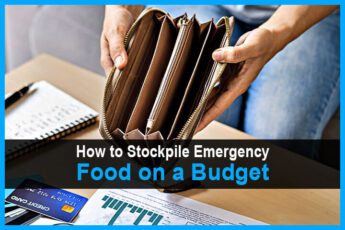Estimated reading time: 15 minutes
I used to think that prepping was a once-and-done activity. And the more money you throw at it, the quicker you can get it done! Imagine purchasing a whole-house solar power system, a lifetime of dehydrated foods, and a never-ending water supply.
If that sounds dreamy, you're right. It's not affordable or attainable for most of us. And if even if it was, those solar panels can break, foods can spoil, and water can get contaminated. It doesn't take much for that big investment to go bad.
I've been through a variety of minor disasters, as I'm sure you have as well – from hurricanes and blizzards to power outages and a pandemic. At times, I've been more prepared, and at other times, I've been less prepared.
But when we stop thinking of preparing as a once-and-done event and think about it as living sustainably no matter what is happening, we end up being more well-rounded and well-balanced when disaster does occur.
I try to consider being prepared as a mindset and part of living a simpler way of life. When we incorporate being prepared into our daily living, it becomes much more affordable and attainable. You don't have to be wealthy or well-off to be prepared. With a little creativity and diligence, you can be just as ready as anyone else.
Take Inventory
Don't go out and willy-nilly purchase supplies. You need to start with a basic plan to get you moving in the right direction. Once you know where you are going, then you can tweak your plan over time.
The first thing to do is take inventory! What are your current circumstances like? What kind of storage do you have, what kind of gardening space do you have, and what kind of budget do you have? What resources do you already have that can be used in an emergency or a disaster? Who do you need to prepare for? You're probably better prepared than you realize.
Once you know what you already have, you can look into adding more of what you need.
Cut Expenses
You'll probably need to spend a little bit of money prepping for disaster, even if you have a tight budget. So think about some simple ways you can cut expenses. You'll want to save up some cash for emergencies and have some money to spend on prepping.
Of course, you'll need to figure out what level is comfortable for you, but we probably have more wiggle room in our budget than we realize. We just need to get creative and look for it.
For example, I have friends who will only pay cash for a car, and they will only buy a used car. They have the skills to do a lot of the maintenance themselves, so that's one way to save a lot of money. This won't work for everyone, so you may have to get creative to find other ways to save money.
I have other friends who limit their entertainment to things that are free or nearly free. So, instead of going to the movies, they go on picnics. Instead of taking expensive vacations, they go camping. They still find plenty of fun things to do and make memories with their families, but they only do the things that fit into their financial goals.
For most of us, it's easier to cut the amount of money we spend rather than trying to make more money. But it is up to you! Find ways that work for you to free up a little extra space in your budget to invest in being prepared.
Avoid Waste: Reuse and Repurpose
I have a large family, and it's easy for waste to get out of control. Food waste is a huge part of our local landfills in the United States. Not to mention, food is expensive, and when we waste it, we waste the money that we spend on it. Another friend of mine grew up with the mantra, “We don't waste food!”
The easiest way to cut food waste in my house is to feed our table scraps to the chickens, who give us plenty of fresh eggs in return.
We also avoid scrap paper waste. My kids bring home tons of worksheets from school. And we reuse them! Most of them become kid toys. The kids use them to play school, make paper airplanes, and do crafts. Every dollar you save here and there becomes an extra dollar you can pour into prepping for disaster or putting into your savings account.
Instead of buying rags, we cut up old t-shirts and towels for cleaning. Cardboard boxes become mulch for the garden and sources of browns for the compost pile. Clothes get passed down from one family member to another (my kids are getting big enough that I can wear their hand-me-downs).
When you start thinking about how to reuse and repurpose items you already have, you get into a preparedness mindset. You'll save money and have more to use in a disaster.
Food
Of course, one of the most critical aspects of being prepared for a disaster is having enough food to eat.
A friend showed me a picture of her stockpile of dehydrated food. Her husband was adamant that they needed five year's worth of stored food on hand. It took up a large portion of her garage – and an even bigger portion of her credit card bill.
There's certainly nothing wrong with purchasing five-gallon buckets of prepackaged survival food. However, these foods are costly, and they may not be things that your family actually eats. On top of that, it's hard to tell if the food has spoiled. There's nothing worse than expecting to have a stockpile of food only to discover it's gone bad and is no longer safe to eat.
FEMA recommends you always have at least three days' worth of food on hand for your family. In my experience, I've found that two weeks is much more realistic. Many of the weather events I've experienced have caused about five days of disruptions, making it hard to get food and water for several days at a time.
But that amount is different for everyone, depending on how much money you have to spend and how much space you have to store it. You'll want to think about how much food you want on hand at all times, whether that's three days or three year's worth. Then, you can start working on that goal.
The key to growing your food stash on a budget is purchasing food your family already eats. Then, as you cook, use the oldest items first and replace them with the newer items. This way, you'll rotate your stock so you always have the freshest food on hand.
Stock up on Sale Items
I use a small portion of my grocery budget each week for stockpiling food. Some weeks, that amount is just a couple of dollars at a time; other weeks, I can squeeze out more. So, I look for foods my family eats when they are on sale.
For example, if green beans are buy three get one free, I'll buy the three cans I'll use this week and have one extra to put into rotation. This way, I'm always adding something to my stash, no matter how small.
Buy in Bulk
Another way to save money is to buy in bulk. Big box stores often offer larger quantities, knowing that most people will waste the extras! But buying in bulk doesn't have to be wasteful.
You may need to separate your goods into smaller containers, but it is possible to save money by buying in large quantities. If it's too much for your family, you could always split or trade with a neighbor or another similarly-minded family.
Buy Store Brand
In many cases, store-brand canned goods are the same as name-brand canned goods. They are often made in the same factory, on the same equipment, with the same ingredients. They're just contracted by companies that use different labels. In my experience, most name-brand goods are generally not better than the store brand.
If you can choose store-brand canned goods over name-brand, you'll save money and be able to put more of your budget into prepping.
Grow a Survival Garden
It is entirely possible to save money by growing your own food. Homegrown food is also more nutrient-dense because you can eat it almost as soon as you pick it. Fresh foods you purchase from the grocery store are often shipped across the country, so it's a longer period from when it's picked to when you can eat it.
But be careful when gardening! It's easy to spend hundreds, if not thousands, purchasing seedlings, prepping the soil, and creating the ideal garden. Remember that a garden doesn't have to be pretty or fancy to sustain you – it just has to grow food.
Choosing fruits and vegetables that grow naturally in your climate will go a long way toward helping you grow more food. Perennials may cost a little more up front, but will reward you with food year after year.
Growing foods from seed is far more cost-effective than purchasing started plants. I often share seed packets with friends, swap seeds, or sell off my extra vegetable starts to make money for garden supplies. There are Mennonite-owned greenhouses near me that offer bulk flats of vegetables at very reasonable prices and they are more than happy to share their knowledge, as well.
Don't waste time and money growing foods you don't eat. Instead, stick to the basics that your family likes, such as tomatoes or carrots. If you don't have the space or time for a whole garden, remember that salad greens are some of the most compact and cost-effective items you can grow.
You can easily grow lettuce or spinach in a container on your balcony or windowsill. It will contribute fresh greens to your diet and save you money.
The more food you grow regularly, the easier it will be to grow your own food in a disaster situation. So even if you can only grow a small garden, it will help you be more prepared in the long run. Don't forget to practice harvesting, storing, and saving seeds.
Raise Animals
Some people will prepare for disaster by raising livestock for food. Not everyone has the time, space, or money to raise animals. However, you might want to add to your preparedness by keeping some chickens, quail, or even meat rabbits.
These small animals are the easiest and cheapest to raise. If needed, you can feed them off table scraps or vegetables from your garden.
I find that raising chickens for eggs is cost-effective when I allow my chickens to free-range and supplement their diets with table scraps. Otherwise, the cost of chicken feed can be very high. So, if you want to raise animals for disaster preparedness or just as part of a more sustainable lifestyle, you'll want to consider the cost.
Canning and Dehydrating
When I was a child, my parents would purchase bulk fruits and vegetables at farmer's markets, and then we would preserve them by canning, freezing, and dehydrating.
Often, at the end of the weekend, farmers will heavily discount their goods at the farmers' market so they don't have to transport them back to the farm or let them go to waste. This is the perfect time to stock up.
Once we would get the food items, then we would preserve them. Fresh fruits would be peeled and cut, mixed with sugar, and frozen so we would have fruit to eat all year long. We would slice sweet corn off the cob, put it in gallon bags, and freeze it.
We would make jams, jellies, and apple butter and can them.
When I got older, I got a dehydrator. Instead of letting my extra garden produce go to waste, I dehydrate and store it for the winter. Things like tomatoes, strawberries, apples, and other fruits and vegetables can be sliced and dehydrated, making delicious and nutritious snacks for the winter.
These items can also be stored for longer terms in mylar bags with oxygen absorbers, giving you food for your disaster stockpile.
Remember to focus your efforts on foods your family enjoys eating because they won't suddenly eat foods they don't like just because it's a disaster. You may also want to keep a few prepared foods on hand that don’t need cooked. Remember to account for any dietary needs that you or your family may have.
Water
Another thing you need to prep for is water. You can go a couple of weeks without food, but you can't go more than a few days without water. FEMA suggests stockpiling enough water to have a minimum of one gallon per person per day for at least three days, if not two weeks or more. You'll need even more if you have animals.
Thankfully, gallons of water are inexpensive, and you can easily add a gallon to your grocery bill each week without feeling too much pain. Water doesn't expire, but it can get contaminated. Plastic jugs can leak over time, so you'll need to monitor your water supply to make sure its ok.
I like to have about 30 gallons of water stored in the basement for drinking only. But 30 gallons won't last long in a disaster, and if the power is out, my well won't pump water. So I also have rain barrels outside. This water can be used for flushing toilets, watering plants, and watering animals if necessary.
I keep a few straw filters on hand in my prepping supplies so that if I run out of water, I can filter the rain barrel water and even boil it. You don't have to spend a lot of money on these – you can buy generic brands or wait for a good sale. Just make sure they filter out the microbes that can make you sick.
Shelter
Of course, you probably already have some sort of shelter or home to live in. Keep your home in good working order and think about things that need updating or fixing to be ready for a disaster. Keeping on top of small problems will help keep them in check before they become bigger, more expensive problems.
Is there anything missing in your home that you would need during a disaster? You may want to consider generators, solar panels, tools to make repairs, and tools for working in the garden. You may want flashlights, candles, and camp stoves, too.
You don't have to go to the store and buy these items brand new! You can shop for these items on Craigslist and Facebook marketplace. If you have a tight-knit community, you might consider starting a ‘tool library' where everyone can contribute and borrow what they need in a communal location.
Or perhaps you are willing to trade tools, skills, or services with friends, neighbors, or other people nearby.
Clothing
Clothing can be complicated if you have growing kids. You may want to always keep a few things on hand for the future, such as a larger-sized coat or spare rain boots ready for next season. Again, you don't have to purchase these at full price. Look for end-of-season sales or, better yet, buy some items at thrift stores and yard sales. You'll save money and have items on hand when needed.
Since I have a lot of kids, I put their old clothes that are still good in bins until the next child grows into them. So, no matter what happens, I always have a few items on hand for everyone. Even if they the items aren’t there personal style, they’ll still work in an emergency.
Warmth
You definitely need to stay warm in a disaster. This is another place where it helps to be preparedness-minded. I'm very fortunate that my home has a good woodstove. I make sure to get it cleaned and inspected every year so it's always ready to go when I need it. I also purchase firewood a year ahead.
This way, I'm not in a crunch trying to buy firewood at the last minute or having to chop wood in the middle of a snowstorm! I support a small local business, and they deliver the firewood when it is convenient. I save money by purchasing it at the end of the season rather than in the middle of winter.
This also helps make sure the firewood is well-seasoned. I won't be worried about trying to burn wood that is too green. So, I'm always prepared, even for an unusually early or late storm. The wood stove isn't large enough to keep the whole house warm, but it is enough to keep a few rooms warm, keep the pipes from freezing, and enables us to cook, too.
If you don't have a wood stove, you might want to look into some backup heaters such as a Mr. Buddy, propane heaters, or even small electric heaters. Heavy wool sweaters, blankets, and socks will go a long way toward keeping your family warm no matter how cold it is inside or outside.
Again, you can find these items on Craigslist, marketplace, or at thrift stores. You can put out a plea on Facebook buy/sell and free pages because someone might just have extra items to give away.
First Aid
First aid is a critical part of being prepared. You need to have a good first aid kit on hand and know how to use it. But you don't have to spend a fortune! There are a lot of first aid items that you can purchase at the dollar store. You can start with a basic kit and slowly add to it over time so that you are prepared for any emergency.
You can also take first aid classes. The Red Cross offers courses for a small fee, but you may be able to find free training through your work or the local YMCA.
Survival Skills
Learning basic skills will help cover over the things you can't afford to buy. There are a lot of ways to learn the skills for free. You might search YouTube for basic gardening, cooking, repair, and animal-raising skills. You can take free community classes on growing and foraging. You could also trade skills with your neighbors or teach each other new skills.
A farmer may allow you to help them with labor in exchange for teaching you all of their ‘trade secrets' on how to grow or raise livestock. And, of course, you can always visit your local library to borrow books on prepping, gardening, and home repair.
Prepping Yourself
One overlooked aspect of prepping is prepping yourself. Eating well, exercising, and caring for yourself doesn't have to cost much money. But being healthy and in shape is priceless in a disaster situation. Make sure you plan for your own health and well-being when you're planning for disaster.
Don't get bogged down by thinking you must spend all your money to be prepared. Remember to take inventory of what resources you already have and make a plan to add what you need over time.
Start with being prepared for three days (you probably already are), and then work on being prepared enough for two weeks. From there, you can work on creating a bigger plan that is specifically tailored to your needs, your budget, and your family.









